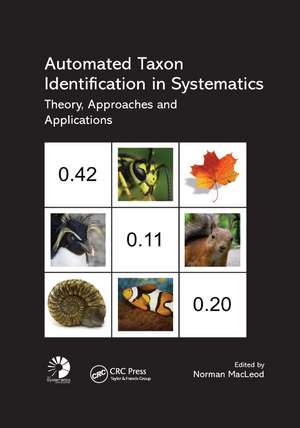Automated Taxon Identification in Systematics: Theory, Approaches and Applications
Editat de Norman MacLeoden Limba Engleză Paperback – 17 oct 2019
Based on evidence accumulated over the last decade and written by applied researchers, Automated Taxon Identification in Systematics explores contemporary applications of quantitative approaches to the problem of taxon recognition. The book begins by reviewing the current state of systematics and placing automated taxon identification in the context of contemporary trends, needs, and opportunities. The chapters present and evaluate different aspects of current automated system designs. They then provide descriptions of case studies in which different theoretical and practical aspects of the overall group-identification problem are identified, analyzed, and discussed.
A recurring theme through the chapters is the relationship between taxonomic identification, automated group identification, and morphometrics. This collection provides a bridge between these communities and between them and the wider world of applied taxonomy. The only book-length treatment that explores automated group identification in systematic context, this text also includes introductions to basic aspects of the fields of contemporary artificial intelligence and mathematical group recognition for the entire biological community.
Preț: 497.45 lei
Preț vechi: 585.24 lei
-15% Nou
Puncte Express: 746
Preț estimativ în valută:
95.20€ • 98.78$ • 79.57£
95.20€ • 98.78$ • 79.57£
Carte tipărită la comandă
Livrare economică 18 martie-01 aprilie
Preluare comenzi: 021 569.72.76
Specificații
ISBN-13: 9780367388836
ISBN-10: 0367388839
Pagini: 368
Dimensiuni: 178 x 254 x 20 mm
Greutate: 0.68 kg
Ediția:1
Editura: CRC Press
Colecția CRC Press
ISBN-10: 0367388839
Pagini: 368
Dimensiuni: 178 x 254 x 20 mm
Greutate: 0.68 kg
Ediția:1
Editura: CRC Press
Colecția CRC Press
Public țintă
Academic and Professional ReferenceCuprins
Introduction. The Need for Automated Approaches to Species Identification. Is Automated Species Identification Feasible? Natural Object Recognition: Machines Vs. Humans. Homology and Morphometrics: An Old Theme Revisited. Plastic Self-Organizing Maps. Decision Trees: A Machine-learning Methodology to Analyze the Relationship between Skeletal Morphology and Ecological Adaptations. DAISY: A Practical Computer Based Tool for Semi-Automated Species Identification. Introducing SPIDA-web: An Automated Identification System for Biological Species. Automated Extraction and Analysis of Morphological Features for Species Identification. Pattern Recognition for Ecological Science and Environmental Monitoring. Identification of Botanical Taxa using Artificial Neural Networks. Use of Neural Nets in Identification of Spheniscid Species. Drawing the Line: the Differentiation Between Morphological Plasticity and Interspecific Variation. Summary and Prospectus.
Descriere
Automated Taxon Identification in Systematics shows how automated identification can be applied to various organismal groups. It is the first text to address the interface between the species recognition question in the biological sciences and the class recognition problem in mathematics and statistics. It will be of interest to taxonomists as well as computational professionals who focus on the biological sciences. Featuring high-profile contributors, the text presents current trends in quantitative approaches to group-recognition challenges, discusses the identification capabilities of current software systems, and evaluates applications of this technology to present and future problems.
